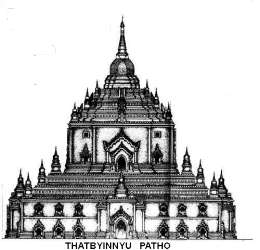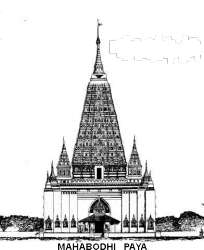
Early
Bagan
style
architecture
Although
this
temple
was
heavily
damaged
by
an
earthquake
in
1975,
it
has
been
totally
restored
and
it
is
now
again,
one
of
the
best
preserved,
finest
and
largest
temples
in
Bagan.
It
has
been
built
in
1105
by
king
Kyanzittha
and
it
measures
53
x
53
by
51
m
high.
Inside
are
four
of
solid
teak
9,5
m
standing
Buddhas,
facing
outwards
from
the
center.
The
base
and
the
terraces
are
decorated
with
554
glazed
tiles,
showing
life
stories
of
Buddha.

Bagan's
Middle
Period
Built
around
1150
by
Alaungsithu.
The
structure
rises
up
to
61m
and
consists
of
2
huge
cubic
buildings
with
3
diminishing
terraces
between
them.
Topped
with
an
idian
style
spire.

Late
Bagan
Period
Modelled
after
the
famous
Mahabodhi
Temple
in
India.
It
was
built
by
Nantaungmya
in
1211
-
1234.
The
pyramidal
spire
is
covered
with
many
hundred
niches,
which
enclose
seated
Buddha
figures.
This
monument
commemorates
the
place,
where
Buddha
attained
enlightment

Also
built
by
king
Nantaungmya
in
1218.
Inside
this
46m
high
temple
are
4
Buddhas
on
the
lower
and
upper
floor.
Traces
of
old
murals
can
be
seen.
Doorways
with
carved
reliefs